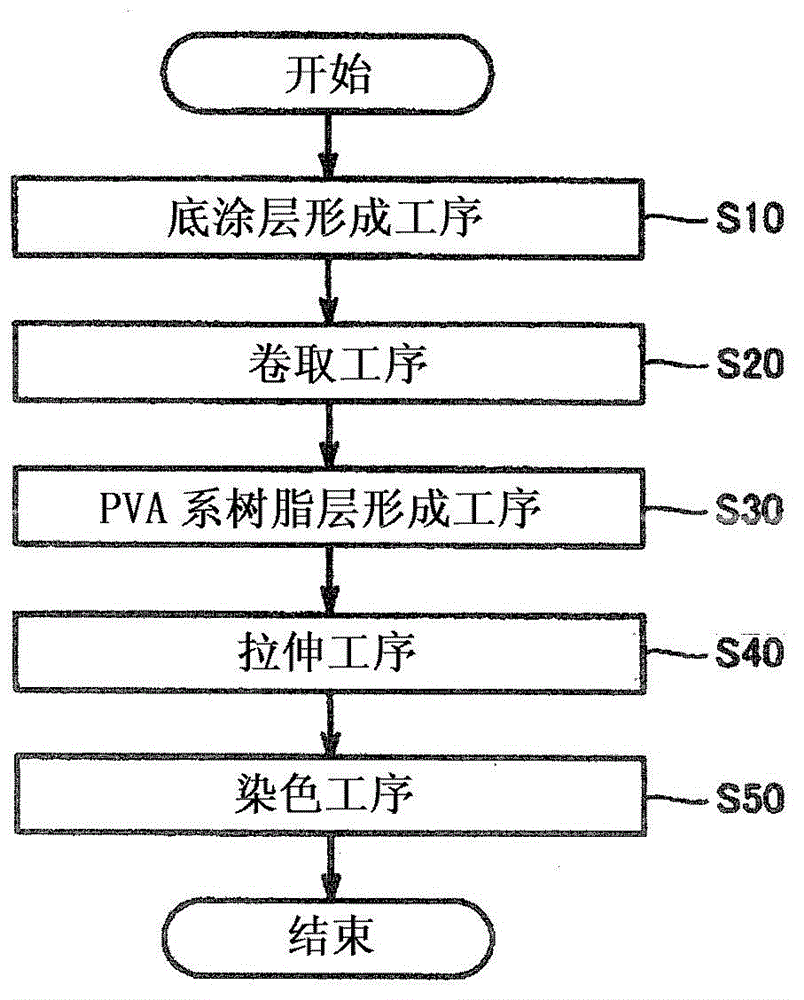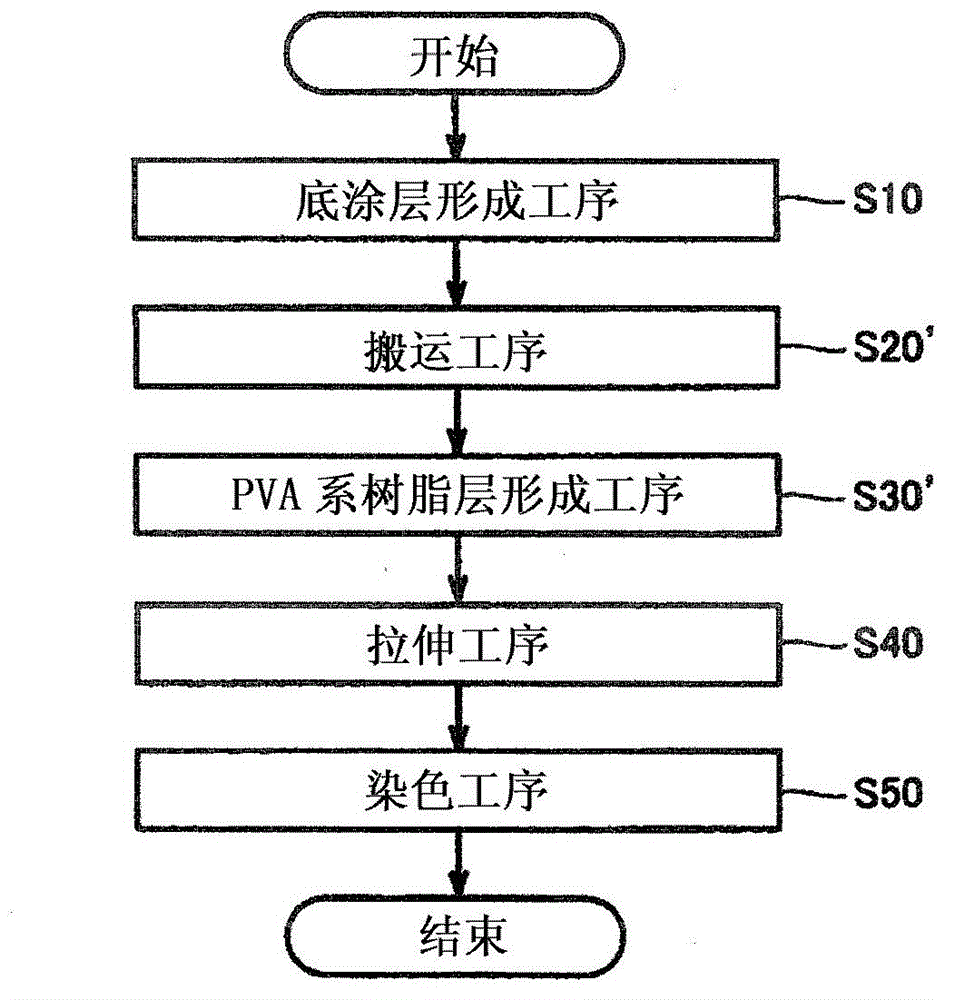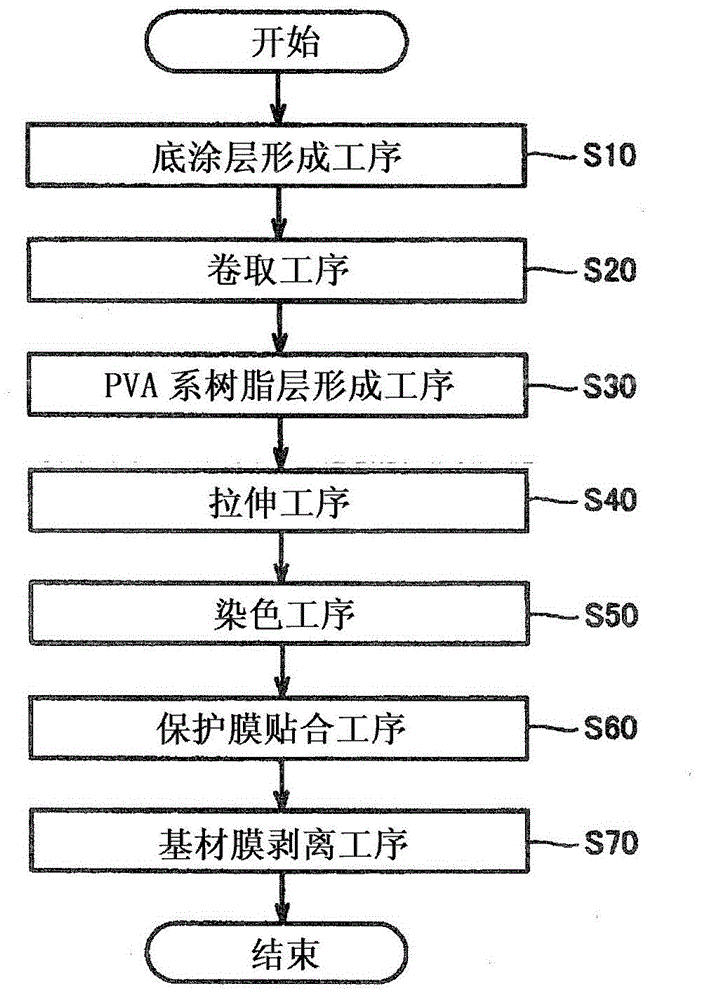Methods for producing polarizing laminate film and polarizing plate
A manufacturing method and a technology for laminating films, applied in polarizing elements, optics, instruments, etc., can solve problems such as poor film handling and adhesion
- Summary
- Abstract
- Description
- Claims
- Application Information
AI Technical Summary
Problems solved by technology
Method used
Image
Examples
Embodiment 1
[0174] according to figure 2 The manufacturing method shown produces a polarizing plate.
[0175] (undercoat layer formation process)
[0176] As the base film, an unstretched polypropylene (PP) film having a thickness of 100 μm was used.
[0177] As a primer solution not containing a crosslinking agent, polyvinyl alcohol powder (manufactured by Nippon Gosei Chemical Industry Co., Ltd., saponification degree 99.5 mol%, trade name: Z-200) was dissolved in hot water at 95°C to prepare An aqueous solution in which the weight ratio of water: polyvinyl alcohol powder is 100:3. The obtained primer solution was coated on the corona-treated substrate film, and dried at 80° C. for 10 minutes to form a primer layer with a thickness of 0.3 μm.
[0178]The experiment shown below was performed about the base film in which this undercoat layer was formed, and the degree of blocking was confirmed.
[0179]
[0180] (1) A film coated with an undercoat layer having a size of 300 mm×220 ...
Embodiment 2
[0203] As the base film, an unstretched polypropylene film having a thickness of 100 μm was used in the same manner as in Example 1.
[0204] Polyvinyl alcohol powder (manufactured by Nippon Synthetic Chemical Industry Co., Ltd., saponification degree 99.5 mol%, trade name: Z-200) was dissolved in hot water at 95°C to prepare water: The weight ratio of polyvinyl alcohol powder was 100: The aqueous solution of 3, and then, add and mix the epoxy-based cross-linking agent solution (Sumika Chemtex Co. , Ltd., trade name: Sumirez (registered trademark) Resin 650, aqueous solution with a solid content concentration of 30% by weight), and prepared as a primer solution. At this time, the concentration of the epoxy-based crosslinking agent (solid content) in the primer solution was 0.04% by weight.
[0205] The obtained primer solution was coated on the corona-treated substrate film, and dried at 80° C. for 10 minutes to form a primer layer with a thickness of 0.2 μm.
[0206] (Adhes...
Embodiment 3
[0225] In this example, as a cross-linking agent for the primer solution, "Orgatics-TC310 (trade name)" (manufactured by Matsumoto Pharmaceutical Co., Ltd., active ingredient (Chem. Structure: (HO) 2 Ti[OCH(CH 3 )COOH] 2 ) 44% by weight, isopropanol 40% by weight and water 16% by weight solution).
[0226] First, solution A was prepared by mixing water, isopropanol, and "Orgatics TC-310" so that the weight ratio of water:isopropanol:TC-310 was 85:15:7.5. Here, the weight ratio of TC-310 refers to the weight of the entire solution containing the organometallic compound.
[0227] In addition, 15 parts by weight of polyvinyl alcohol powder (manufactured by Kuraray Co., Ltd., saponification degree: about 80 mol%, trade name: KL506) was dissolved in 100 parts by weight of water at 80°C to prepare an aqueous solution of polyvinyl alcohol ( Solution B).
[0228] Solution A and solution B were mixed so that the weight ratio of solution A:solution B was 1.3:4 to prepare a primer s...
PUM
| Property | Measurement | Unit |
|---|---|---|
| thickness | aaaaa | aaaaa |
| thickness | aaaaa | aaaaa |
| thickness | aaaaa | aaaaa |
Abstract
Description
Claims
Application Information
 Login to View More
Login to View More - R&D
- Intellectual Property
- Life Sciences
- Materials
- Tech Scout
- Unparalleled Data Quality
- Higher Quality Content
- 60% Fewer Hallucinations
Browse by: Latest US Patents, China's latest patents, Technical Efficacy Thesaurus, Application Domain, Technology Topic, Popular Technical Reports.
© 2025 PatSnap. All rights reserved.Legal|Privacy policy|Modern Slavery Act Transparency Statement|Sitemap|About US| Contact US: help@patsnap.com



